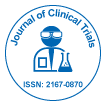
Journal of Clinical Trials
Open Access
ISSN: 2167-0870

ISSN: 2167-0870
Ravi Babu Birudu, Anil Inti, Lokeswara Balakrishna Sunnam, Sridevi Parikipandla*
Haemoglobinopathies are primarily associated with thalassemia and Sickle Cell Disease (SCD). SCD is one of the severe inheritable illnesses in world. Mutations in the HBB gene cause Sickle Cell Disease (SCD). Patients with SCD experience a variety of excruciating sensations, as well as headaches, liver and splenic sequestration issues and jaundice. Children are unable to attend school as a result. The main things impacted are low academic performance, grade retention, intellectual disability and absenteeism. This review article examines the impact of SCD on children's schooling and also suggests interventions which can be carried on for better performance of children with SCD. Sickle Cell Disease (SCD) is a heritable (genetic) disorder and is marked by sporadic episodes of severe pain and hosts other health issues. About 5% of people worldwide suffer from this most common haemoglobinopathy. More than 7% of expectant mothers have haemoglobinopathies in their genetic composition. Each year 330,000 newborns are born with haemoglobinopathies. Nearly 80% of them are born in Africa, Nigeria, Congo and India. Children with SCD have health challenges that impact their education. Absence from school, grade retention, academic performance and dropouts from school are major issues for children with SCD in the context of academic goals. The main objective of this paper is to understand how SCD affects the school performance of children globally, impact on their education and possible interventions and strategies to reduce school absenteeism. Studies suggest that parents, patients, educators and healthcare professionals can work together to comprehend and manage the effects of SCD on student attendance. Awareness campaigns for educators and care givers, remedial classes for SCD children in schools and policies aligning to the education of children with major disabilities like SCD may compensate the attendance and academic performance of the SCD children.
Published Date: 2025-07-07; Received Date: 2025-05-29